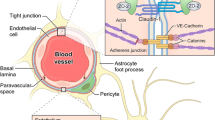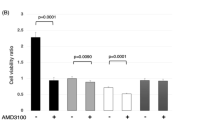Abstract
To study the effects of glucocorticoids and chemotherapeutic agents on the pathophysiology of the tumor-induced brain edema, the site of Evans blue-albumin extravasation, the distribution of extravasated serum albumin, and the extent of local astrocytic reaction were examined in a rat model of implanted brain tumor. Experimental brain tumors were produced by implanting small pellets of Walker 256 carcinosarcoma into the cerebral cortex of Wistar rats. In the steroid group, rats were administered with intraperitoneal methylprednisolone succinate (15 mg/kg) daily on and after the 6th day postimplantation, and sacrificed on the 14th day. In the chemotherapy group, rats were given an intravenous injection of cyclophosphamide (30 mg/kg) on the 14th day, and sacrificed on the 21st day. Rats in the untreated group were sacrificed on the 14th day without any therapy. Each animal was sacrificed by the transcardiac perfusion with paraformaldehyde 30 min after intravenous injection of Evans blue. Firstly, coronal blocks of the brain were examined for Evans blue staining macroscopically. Paraffin embedded sections were studied for the Evans blue fluorescence and for the immunohistochemical reaction to serum albumin and GFAP. The examination of Evans blue demonstrated that the origin of extravasation of serum albumin was the tumor and the adjacent brain with dense tumor cell infiltration in any group of rats. The extravasated serum albumin distributed widely and the astrocytic reaction was prominent in the brain of the untreated group. A positive correlation was observed between the intensity of albumin immunoreaction and the degree of astrocytic proliferation. Chemotherapy effectively decreased the size of tumor and reduced the extravasation of serum albumin. The astrocytic reaction was however, not reduced. In the steroid group, the size of tumor was not significantly affected but the albumin extravasation as well as astrocytic reaction was markedly reduced. It was concluded that glucocorticoid is an effective drug against tumor-induced brain edema, which not only reduces the extravasation of serum components but also prevents histologic alterations of the brain.
Similar content being viewed by others
References
Reulen GH, Graham R, Spatz M, Klatzo I: Role of pressure gradients and bulk flow in dynamics of vasogenic brain edema. J Neurosurg 46: 24–35, 1977
Hossman KA, Hurter T, Oschlies: The effect of dexamethasone on serum protein extravasation and edema development in experimental brain tumors of cat. Acta Neuropathol (Berl) 60: 223–231, 1983
Jamshidi J, Yoshimine T, Ushio Y, Hayakawa T, Morimoto K, Mogami H: Pathology of brain parenchyma in meningeal carcinomatosis: Immunohistochemical study with astroprotein (GFAP) and tubulin. J Neuro-Oncology 5: 65–71, 1987
Klatzo I, Piraus A, Laskowski EJ: The relationship between edema, blood brain barrier and tissue elements in a local brain injury. J Neuropathol Exp Neurol 17: 548–564, 1958
Yoshimine T, Ushio T, Hayakawa T, Arita N, Mori T: Ependymal reaction to stab wounds in rat brains — Immunohistochemical study with antiserum to astroprotein-. Neurologia Medico-Chirurgica 22: 19–23, 1982
Yoshimine T, Ushio Y, Hayakawa T, Takemoto O, Maruno M, Mogami H: Growth activity of tumors at different intracranial structures: Immunohistochemical study with bromodeoxyuridine. Acta Neuropathol (Berl) 17: 15–18, 1986
Yoshimine T, Morimoto K, Bregman JM, Homburger HA, Mogami H, Yanagihara T: Immunohistochemical investigation of cerebral ischemia during recirculation. J Neurosurg 63: 922–928, 1985
Deane BR, Lantos PL: The vasculature of experimental brain tumors. J Neurol Sci 49: 55–66, 1981
Hirano A, Matsui T: Vascular structures in brain tumors. Human Pathology 6: 611–621, 1975
Stewart PA, Hayakawa K, Farrell CL, Del Maestro RF: Quantitative study of microvessel ultrastructure in human peritumoral brain tissue. J Neurosurg 67: 697–705
Yamada K, Ushio Y, Hayakawa T, Arita N, Yamada N, Mogami H: Effects of methylprednisolone on peritumoral brain edema. A quantitative autoradiographic study. J Neurosurg 59: 612–619, 1983
Ohnishi T, Sher PB, Posner JB, Shapiro WR: Capillary permeability factor secreted by malignant brain tumor: Role in peritumoral brain edema and possible mechanism for anti-edema effect of glucocorticoids. J Neurosurg 72: 245–251, 1990
Hall ED, Braughler JK: Effects of intravenous methylprednisolone on spinal cord lipid peroxidation and (Na-K)-ATPase activity. J Neurosurg 57: 247–253, 1982
Love JA, Friden H, Ekstedt J: The effect of corticosteroids at the level of the arachnoid ville. In: Go KG and Baethman A (eds) Recent progress in the study and therapy of brain edema. Plenum Press, New York and London pp 589–595, 1984
Sato O: The effect of dexamethasone on CSF production rate in the dog. Brain and Nerve (Tokyo) 19: 485–492, 1969
Cavanagh JB: The proliferation of astrocytes around a needle wound in the rat brain. J Anat 106: 471–487, 1970
Szymas J, Hossman KA: Effect of dexamethasone on glial fibrillary acidic protein in peritumorous edema of cats: A morphometric study. Acta Neuropathol (Berl) 62: 309–315, 1984
Ikuta F, Yoshida Y, Ohma E, Oyanagi K, Takeda S, Yamazaki K, Watanabe K: Revised pathophysiology on BBB damage: The edema as an ingeniously provided condition for motility and lesion repair. Acta Neuropathol (Berl) Suppl VIII: 103–110, 1983
Klatzo I: Neuropathological aspects of brain edema. J Neuropathol Exp Neurol 26: 1–14, 1967
Hanson GR, Partlow LW: Stimulation of non-neuronal cell in vitro by mitogenic factors present in highly purified sympathetic neurons. Brain Res 159: 195–210, 1978
Sheffield WD, Kim SU: Myelin basic protein causes proliferation of lymphocytes and astrocytes in vitro. Brain Res 132: 580–584, 1977
Mealey JJR, Tsu TC, Schanz GP: Effects of dexamethasone and methylprednisolone on cell cultures of human glioblastoma. J Neurosurg 34: 324–334, 1971
Wright RL, Shaumaba B, Keller JBA: The effect of glucocorticoids on growth and metabolism of experimental glial tumors. J Neurosurg 39: 140–145, 1969
Author information
Authors and Affiliations
Rights and permissions
About this article
Cite this article
Jamshidi, J., Yoshimine, T., Ushio, Y. et al. Effects of glucocorticoid and chemotherapy on the peritumoral edema and astrocytic reaction in experimental brain tumor. J Neuro-Oncol 12, 197–204 (1992). https://doi.org/10.1007/BF00172707
Issue Date:
DOI: https://doi.org/10.1007/BF00172707




